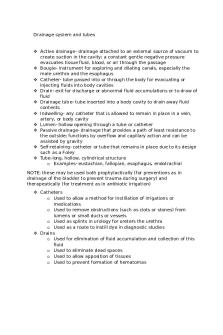11. Arterial supply and venous drainage of the face and the parotid gland PDF

| Title | 11. Arterial supply and venous drainage of the face and the parotid gland |
|---|---|
| Author | Stephen Lenaghan |
| Course | Anatomical basis of clinical practice 2 |
| Institution | Queen's University Belfast |
| Pages | 3 |
| File Size | 95.6 KB |
| File Type | |
| Total Downloads | 80 |
| Total Views | 158 |
Summary
Arterial supply and venous drainage of the face and the parotid gland...
Description
Describe the arterial supply and venous drainage of the face and identify the principal vessels involved Arterial supply Facial Artery o Major vessel supplying the face. o Branches from the anterior surface of the external carotid artery. o The facial artery runs upwards and medially in a tortuous course. o Passes along the side of the nose and terminates as the angular artery at the medial corner of the eye. o Branches of the facial artery include the superior and inferior labial branches and the lateral branch. o The labial branches arise near the corner of the mouth: The inferior labial branch supplies the lower lip. The superior labial branch supplies the upper lip. The lateral nasal branch is a small branch arising from the facial artery as it passes along the side of the nose; it supplies the lateral surface and dorsum of the nose.
Transverse Facial Artery o Branch of the superficial temporal artery – the superficial temporal artery ascends anterior to the ear, over the superficial temporal region of the skull. o Passes through the parotid gland and crosses the face in a transverse direction. o Lying on the superficial surface of the masseter muscle, it is between the zygomatic arch and the parotid duct.
Venous drainage Facial Vein o Major vein draining the face. o Its point of origin is near the medial corner of the orbit as the supratrochlear and the supra-orbital veins come together to from the angular vein. o This vein becomes the facial vein as it proceeds inferiorly and assumes a position just inferior to the facial artery. o The facial vein passes superficial to the submandibular gland to enter the internal jugular vein. o Throughout its course, the facial vein receives tributaries from the veins draining the eyelids, external nose, lips, cheek, and chin that accompany the various branches of the facial artery.
Transverse Facial Vein o Small vein that accompanies the transverse facial artery in its journey across the face. o Empties into the superficial temporal vein within the substance of the parotid gland.
Describe the anatomy and relations of the parotid glands; identify the parotid glands and the key anatomical features of these glands The parotid glands, the largest of the three paired salivary glands, are found within the parotid region of the face. The parotid region is bounded as follows: Superiorly – Zygomatic arch. Inferiorly – Inferior border of the mandible. Anteriorly – Masseter muscle. Posteriorly – External ear and sternocleidomastoid The parotid duct rises from the anterior border of the gland and travels in a transverse direction across the face, superficial to the masseter muscle. It then turns deeply piercing the buccal fat pad before piercing buccinator to move medially and enter the oral cavity – the duct opens in the mouth at the level of the second upper molar. Relations of the parotid glands Several neurovascular structures pass through the gland the facial nerve (CN VII) o gives rise to 5 terminal branches in the gland – the branches innervate the muscles of facial expression 1. temporal – innervates frontalis and orbicularis oculi 2. zygomatic – innervates orbicularis oculi 3. buccal – innervates orbicularis oris, buccinator and zygomaticus muscle 4. (marginal) mandibular – innervates mentalis 5. cervical – innervates platysma the external carotid artery (and its branches) o gives rise to the maxillary artery and the superficial temporal artery within the gland the retromandibular vein o forms in the parotid gland as a convergence of the superficial temporal vein and the maxillary vein Arterial supply to the gland = maxillary and the superficial temporal arteries Venous drainage = retromandibular vein Innervation = glossopharyngeal nerve (CN IX)
Describe and identify the location, structure and contents of the carotid sheath Each carotid sheath is a condensation of deep fascia in the neck that surrounds the common carotid artery, the internal carotid artery, the internal jugular vein, and the vagus nerve as these structures pass through the neck.
Describe the origin, course and distribution of the external carotid artery and branches and identify the internal carotid artery and branches Near the superior edge of the thyroid cartilage (vertebral level C3/C4) each common carotid artery divides into its two terminal branches – the external and internal carotid arteries. The external carotid arteries begin giving off branches immediately after the bifurcation of the common carotid arteries. Branch Superior Thyroid Artery Ascending Pharyngeal Artery Lingual Artery Facial Artery Occipital Artery Posterior Auricular Artery Maxillary Artery Superficial Temporal Artery
Supplies Thyroid muscle, sternocleidomastoid muscle, thyroid gland. Palate, Tonsil, Pharyngotympanic Tube, Meninges in posterior cranial fossa. Muscles of the tongue, palatine tonsil, soft palate, epiglottis, floor of mouth, sublingual gland. All structures in the face, the soft palate, palatine tonsil, Pharyngotympanic tube, submandibular gland. Sternocleidomastoid muscle, meninges in posterior cranial fossa, posterior scalp. Parotid gland and nearby muscles, external ear and scalp posterior to the ear, middle and inner ear structures. External acoustic meatus, temporomandibular joint (TMJ), Mylohyoid muscle. Parotid gland and duct, masseter muscle, anterior part of external ear, temporalis muscle, parietal and temporal muscle.
‘Some Anatomists Like Freaking Out Poor Medical Students’...
Similar Free PDFs

Hypothalamus and Pituitary Gland
- 7 Pages

THE DESIGN OF A NEW KATANGA DRAINAGE
- 106 Pages

The North Face
- 22 Pages

Analysis The North Face
- 4 Pages

Drainage system and tubes
- 5 Pages
Popular Institutions
- Tinajero National High School - Annex
- Politeknik Caltex Riau
- Yokohama City University
- SGT University
- University of Al-Qadisiyah
- Divine Word College of Vigan
- Techniek College Rotterdam
- Universidade de Santiago
- Universiti Teknologi MARA Cawangan Johor Kampus Pasir Gudang
- Poltekkes Kemenkes Yogyakarta
- Baguio City National High School
- Colegio san marcos
- preparatoria uno
- Centro de Bachillerato Tecnológico Industrial y de Servicios No. 107
- Dalian Maritime University
- Quang Trung Secondary School
- Colegio Tecnológico en Informática
- Corporación Regional de Educación Superior
- Grupo CEDVA
- Dar Al Uloom University
- Centro de Estudios Preuniversitarios de la Universidad Nacional de Ingeniería
- 上智大学
- Aakash International School, Nuna Majara
- San Felipe Neri Catholic School
- Kang Chiao International School - New Taipei City
- Misamis Occidental National High School
- Institución Educativa Escuela Normal Juan Ladrilleros
- Kolehiyo ng Pantukan
- Batanes State College
- Instituto Continental
- Sekolah Menengah Kejuruan Kesehatan Kaltara (Tarakan)
- Colegio de La Inmaculada Concepcion - Cebu










